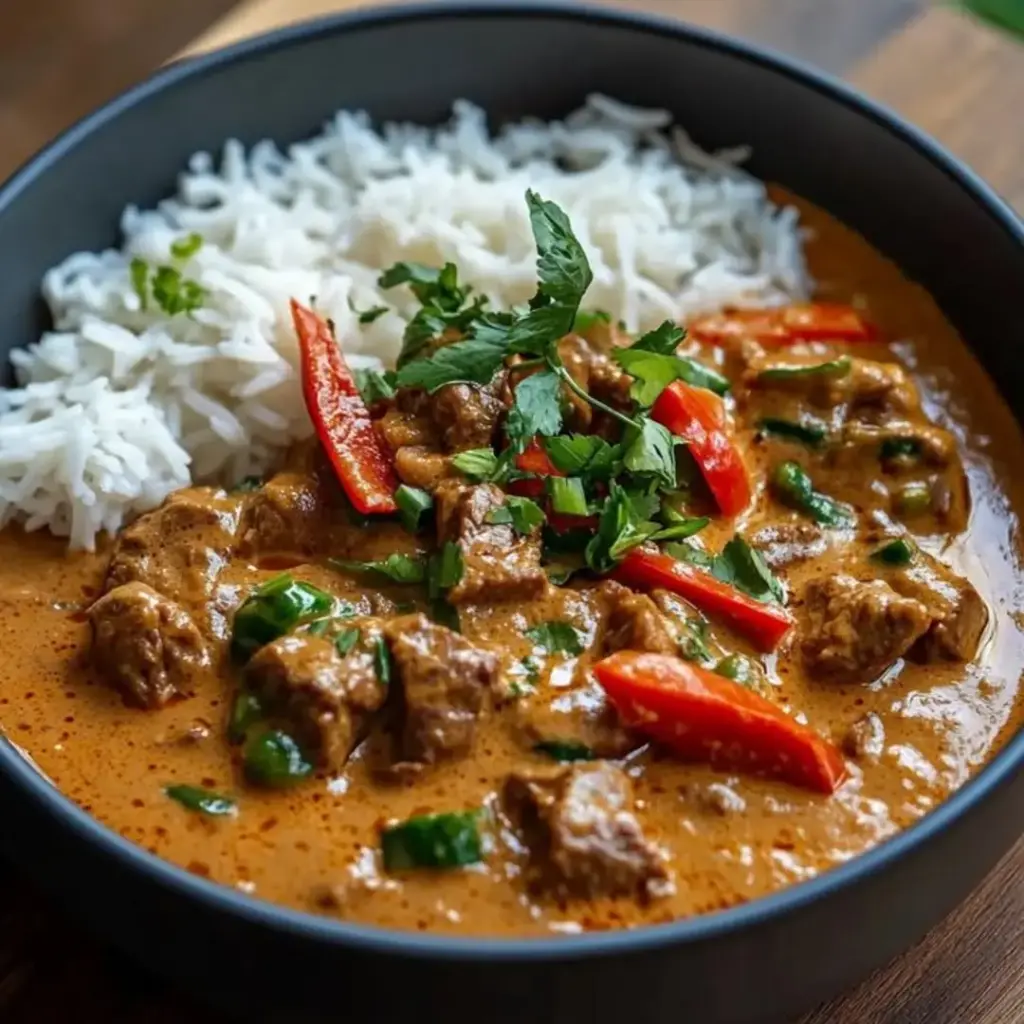Last Updated on 20/06/2025 by SAVORY DELIGHT RECIPES LLC
Introduction
Imagine the creamy richness of coconut milk, infused with the fiery warmth of chilies and the savory depth of tender beef. That’s the magic of Panang Beef Curry, a dish that dances on your palate with its exquisite balance of sweet, spicy, and savory notes. This isn’t just a recipe; it’s your ultimate guide to creating a Panang Beef Curry that rivals your favorite Thai restaurant. We’ll unlock the secrets of this fragrant delight, ensuring your culinary journey is both seamless and utterly delicious. Get ready to embark on a flavor adventure, transforming simple ingredients into an unforgettable aromatic experience. This guide will leave you feeling confident, skilled, and ready to share this incredible dish with everyone you know.
Why You Will LOVE This Panang Beef Curry Recipe
This Panang Beef Curry recipe isn’t just another dish; it’s a culinary experience that will leave you craving more. Here’s why you’ll fall head over heels for it:
- Quick & Easy Weeknight Dinner: Ready in under 45 minutes, it’s perfect for busy evenings.
- Authentic Thai Flavors: Experience the true taste of Thailand in your own kitchen.
- Customizable Spice Level: Adjust the heat to your liking, from mild to fiery.
- Impressive Presentation: This dish looks as good as it tastes, perfect for entertaining.
- One-Pot Wonder: Less cleanup, more enjoyment! All the magic happens in a single pot.
What Does It Taste Like?
Panang Beef Curry is a symphony of flavors. The first bite delivers a creamy wave of coconut milk, perfectly offset by the bold, aromatic spices of the Panang curry paste. A gentle warmth from chilies tingles on the tongue, followed by the savory richness of tender beef. Notes of nutty peanut, fragrant lemongrass, and a hint of sweetness create a complex, harmonious blend. The texture is velvety smooth, coating your mouth with each satisfying spoonful. The aroma alone, a heady mix of exotic spices and creamy coconut, is enough to transport you to the bustling streets of Bangkok.
What Makes This Panang Beef Curry Recipe Uniquely Irresistible & What Are The Hidden Nutritional Benefits?
Quick Prep & Pantry-Friendly Perks
This Panang Beef Curry recipe is designed for efficiency. No need to spend hours in the kitchen! With minimal chopping and a streamlined cooking process, you can have a restaurant-quality meal on the table in less than an hour. Many of the ingredients, like coconut milk and curry paste, are pantry staples, meaning you can whip up this delicious dish whenever the craving strikes, with minimal planning required.
Hidden Health/Nutrition Benefits
Beyond its incredible taste, Panang Beef Curry also offers some surprising nutritional benefits. The coconut milk is a source of healthy fats and the beef provide a great boost of protein and essential minerals. The curry paste itself is packed with spices like turmeric and ginger, known for their anti-inflammatory properties.
Main Ingredients: Your Key to Flavor Success!
- 1.5 lbs beef (sirloin or chuck), thinly sliced
- 2 tbsp vegetable oil
- 3 tbsp Panang curry paste
- 1 can (14 oz) coconut milk
- 1 cup beef stock
- 1 tbsp fish sauce
- 1 tbsp palm sugar (or brown sugar)
- 2 kaffir lime leaves, torn
- 1 red bell pepper, sliced
- 1/4 cup chopped peanuts, for garnish
- 2 tbsp fresh cilantro, chopped, for garnish
Now, let’s delve deeper into the crucial role of some key ingredients.
Panang Curry Paste: This is the heart and soul of your Panang Beef Curry. Opt for a high-quality, authentic paste for the best flavor. Look for one with a vibrant red color and a strong aroma of chilies, lemongrass, and galangal. Lower quality pastes may be bland or overly salty, so invest in a good one!
Coconut Milk: Full-fat coconut milk is essential for the creamy, rich texture that defines Panang Beef Curry. Don’t skimp on this ingredient! The fat content contributes significantly to the overall flavor and mouthfeel. Using light coconut milk will result in a thinner, less satisfying curry.
Fish Sauce: Don’t be intimidated by the pungent smell; fish sauce is a key ingredient that adds a salty, umami depth to your Panang Beef Curry. A little goes a long way, so add it gradually and taste as you go. It provides a savory backbone that balances the sweetness and spice.
Beef: The cut of beef you choose will affect the final result. Sirloin is a leaner option that cooks quickly, while chuck steak is more flavorful and tender after a longer braise. Thinly slicing the beef ensures it cooks evenly and absorbs the flavors of the curry sauce.
Ingredient Swaps, Smart Substitutions & Flavorful Additions
- Gluten-Free: Use tamari instead of fish sauce to ensure a gluten-free
Panang Beef Curry. - Vegan: Substitute the beef with firm tofu or tempeh for a plant-based option.
- Vegetarian: Use a mix of vegetables like broccoli, cauliflower, and bell peppers in place of the beef.
- No Palm Sugar: Brown sugar or honey can be used as a substitute for palm sugar.
- No Kaffir Lime Leaves: Substitute with a little lime zest and juice.
For extra flavor:
- Thai Basil: Add fresh Thai basil leaves at the end for a fragrant aroma.
- Lime Juice: A squeeze of fresh lime juice brightens the flavors and adds a zesty touch.
Tools and Equipment Needed: Your Kitchen Arsenal
- Large skillet or wok: Essential for even cooking and ample space.
- Cutting board and sharp knife: For prepping the beef and vegetables.
- Measuring spoons and cups: For accurate ingredient measurements to ensure consistent results.
- Ladle: For serving your delicious dish.
Tap Showcase to grab the tools you need for this recipe—and every recipe you’ll love!
Don’t waste your time searching! Click the links above to get the perfect tools that will enhance your kitchen experience.
By using my affiliate link, you’ll enjoy exclusive discounts and quality guarantees. Why wait? Simplify every step of your cooking with the tools you need now!
Step-by-Step Instructions: Mastering Your Panang Beef Curry!
-
Prepare the beef: Thinly slice the beef against the grain into bite-sized pieces. Set aside.
Pro Tip: Partially freezing the beef for about 30 minutes makes it easier to slice thinly. -
Heat the oil: In a large skillet or wok, heat the vegetable oil over medium-high heat.
Why this works: A hot pan ensures the beef sears quickly, developing a flavorful crust. -
Sear the beef: Add the sliced beef to the hot skillet and sear until browned on all sides. Remove the beef from the skillet and set aside.
Pro Tip: Avoid overcrowding the skillet, sear the beef in batches if necessary. Overcrowding will steam instead of sear the beef. -
Sauté the curry paste: Add the Panang curry paste to the skillet and sauté for 1-2 minutes, until fragrant.
Why this works: Sautéing the curry paste releases its aromatic oils and intensifies the flavor. -
Add coconut milk and beef stock: Pour in the coconut milk and beef stock. Stir to combine and bring to a simmer.
Pro Tip: Use a wooden spoon to scrape up any browned bits from the bottom of the skillet for extra flavor. -
Season the sauce: Add the fish sauce, palm sugar (or brown sugar), and kaffir lime leaves. Stir to dissolve the sugar and fish sauce.
Why this works: This creates a balanced sweet and savory base for the curry. -
Return the beef: Return the seared beef to the skillet.
Pro Tip: Ensure the beef is submerged in the curry so it can become tender and infused with flavour. -
Simmer the curry: Reduce the heat to low, cover, and simmer for 20-25 minutes, or until the beef is tender and the sauce has thickened.
Why this works: Slow simmering allows the flavors to meld together and the beef to become incredibly tender. -
Add bell pepper: Add the sliced bell pepper and simmer for another 5 minutes, or until the pepper is tender-crisp.
Pro Tip: Adding the bell pepper towards the end prevents it from becoming mushy. -
Garnish and serve: Garnish with chopped peanuts and fresh cilantro. Serve hot with steamed rice.
Why this works: The peanuts add a satisfying crunch, while the cilantro provides a burst of freshness.
Tips for Unbeatable Success: Secrets From Our Kitchen
- Use High-Quality Curry Paste: The quality of your curry paste significantly impacts the flavor of your
Panang Beef Curry. Choose a reputable brand with authentic ingredients. - Don’t Overcook the Beef: Overcooked beef will be tough and dry. Sear it quickly and simmer it gently for tender results.
- Taste and Adjust Seasoning: Taste the curry throughout the cooking process and adjust the seasoning as needed. Add more fish sauce for saltiness, palm sugar for sweetness, or chili flakes for heat.
- Use Fresh Kaffir Lime Leaves: Fresh kaffir lime leaves add a unique citrusy aroma to the curry. If you can’t find fresh leaves, you can use dried leaves, but the flavor won’t be as intense.
- Simmer Gently: Avoid boiling the curry, as this can cause the coconut milk to separate. Simmering gently allows the flavors to meld together without curdling the sauce.
- Garnish Generously: Don’t skimp on the garnishes! Chopped peanuts and fresh cilantro add flavor, texture, and visual appeal to your
Panang Beef Curry.
Assembly, Dazzling Presentation & Irresistible Serving Suggestions
Final Assembly & Presentation Ideas
To create a visually stunning Panang Beef Curry, start by spooning a generous portion of fluffy steamed jasmine rice onto a plate or bowl. Ladle the curry over the rice, ensuring the tender beef and colorful bell peppers are prominently displayed. Garnish generously with chopped peanuts and fresh cilantro for a pop of color and texture. A sprinkle of red pepper flakes adds a touch of heat and visual interest. For an extra touch of elegance. You can also add a drizzle of coconut cream in a circular pattern and drag a toothpick through it to create a swirl design.
Suggested Sides, Drinks & Complements
- Steamed Jasmine Rice: The perfect accompaniment to soak up the delicious curry sauce.
- Thai Iced Tea: A sweet and creamy beverage to balance the spiciness of the curry.
- Cucumber Salad: A refreshing and crunchy salad to cleanse the palate.
- Spring Rolls: Crispy spring rolls filled with vegetables and served with a dipping sauce for a satisfying appetizer.
Smart Storage & Efficient Preparation Tips
Storage Guidelines
Allow the leftover Panang Beef Curry to cool completely before transferring it to an airtight container. Store in the refrigerator for up to 3-4 days. You can also freeze the curry for up to 2-3 months. Thaw overnight in the refrigerator before reheating.
Make-Ahead Prep Tips
- Slice the Beef: Slice the beef ahead of time and store it in the refrigerator until ready to cook.
- Chop the Vegetables: Chop the bell pepper and cilantro in advance and store them in separate containers in the refrigerator.
Spectacular Recipe Variations: Beyond The Basics
- Panang Chicken Curry: Substitute the beef with chicken thighs for a lighter option.
- Panang Shrimp Curry: Use shrimp instead of beef for a quick-cooking and delicious seafood version.
- Panang Tofu Curry: Replace the beef with tofu for a vegetarian twist. Press the tofu to remove excess moisture and pan-fry until golden brown before adding it to the curry.
- Spicier Panang Curry: Add extra chili flakes or a chopped Thai chili to the curry paste for a fiery kick.
The Untold Story: History, Cultural Background & Recipe Trivia
Panang Beef Curry is a dish with deep roots in Thai cuisine. It is believed to have originated in the southern region of Thailand, near the island of Penang (from which it gets its name.) However, contrary to popular belief, the dish is not actually from Penang, Malaysia. Instead, it’s thought that the name alludes to the dish’s subtle sweetness and richness, qualities that Thai people associate with the Malaysian island. The curry is characterized by it’s thick texture and nutty flavor imparted by peanuts. Fun fact: Panang Beef Curry is often considered a milder and sweeter alternative to other Thai curries, making it a great option for those who are sensitive to spice.
Complete Nutritional Information (Per Serving)
| Nutrient | Amount (Per Serving) |
|—|—|
| Calories | 450 |
| Protein | 30g |
| Carbohydrates | 25g |
| Fat | 25g |
| Fiber | 5g |
| Sodium | 800mg |
Answering Your Burning Questions: Panang Beef Curry FAQs
- Can I use light coconut milk? While you can, it’s not recommended. The richness from full-fat coconut milk is essential for authentic flavor and texture. Light coconut milk will result in a thinner, less satisfying curry.
- How do I adjust the spice level? Start with a smaller amount of curry paste and add more to taste. You can also add chili flakes for extra heat.
- What can I use if I can’t find kaffir lime leaves? A little lime zest and juice can be used as a substitute, but the flavor won’t be exactly the same.
- My curry is too thick. What do I do? Add a little beef stock or water to thin it out.
- Can I make this in a slow cooker? Yes! Sear the beef and sauté the curry paste as directed, then transfer everything to a slow cooker. Cook on low for 6-8 hours, or on high for 3-4 hours. Add the bell pepper during the last 30 minutes of cooking.
If You Adored This Panang Beef Curry Extravaganza…
If you loved the creamy, flavorful goodness of this Panang Beef Curry, you’ll also adore these similar Thai dishes:
- Green Curry: Another classic Thai curry with a vibrant green color and a slightly spicier flavor profile.
- Massaman Curry: A mild and fragrant curry with potatoes, peanuts, and a hint of sweetness, perfect for those who prefer a less spicy option. Because of its creamy, rich depth, this curry will definitely be a hit!
- Looking for another beef recipe? Why not try this tender slow-cooked beef curry that will keep you cozy.
- Also, enjoy this light and zesty creamy rigatoni for a different palette option!
- Looking for some heat? Try this Spicy Cajun chicken bites with garlic parmesan pasta.
- Savory Baked Feta Penne Pasta: 3 Simple Ingredient Recipe - 20/07/2025
- Beef Tortellini Alfredo: 3 Easy Recipe Steps - 20/07/2025
- Spicy Cajun Steak Alfredo : 5 Secrets You Need To Know - 20/07/2025




